Are you interested in designing your own knitting projects — perhaps hats, scarves, cowls, mittens, fingerless gloves, blankets, socks and similar projects? Would you be interested in having a handy shortcut to creating brand new, innovative designs using richly textured knitting stitch patterns? And are you interested in finding stitches that look amazing, but aren’t too difficult to knit? If so, there is a brand new knitting stitch dictionary I think you’ll be thrilled to learn about. It’s called Japanese Knitting Stitches From Tokyo’s Kazekobo Studio: A Dictionary of 200 Stitch Patterns by Yoko Hatta.
What You Need to Know About This Knitting Stitch Dictionary:
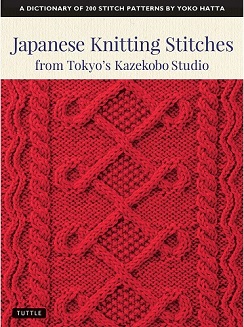
Author: Yoko Hatta designed the knitting stitch patterns and projects found in this book. Cassandra Harada translated the book into English from its original Japanese and wrote the introduction to the book.
Publisher: Tuttle Publishing
Copyright Date: 2019
ISBN 13: 978-4805315187
ISBN 10: 4805315180
Book Formats:
This book is available in the following format(s):
- Softcover With Perfect Binding
- Digital download: Kindle e-book edition
Number of Pages: 128
Skill Level: I recommend this book to knitters of all skill levels, from beginner through advanced.
There are some super easy, basic knitting stitches included in this book — and there are some challenging stitches, too. I own several of the Tuttle knitting stitch dictionaries — and, out of all of the ones I have in my library, my opinion is that this one has the most options for beginner-friendly stitches. But, there’s also plenty of material here to challenge you. Overall, I think this book offers a fantastic variety of stitches for knitters of different skill levels.
The Focus of This Book:
Yoko Hatta, the author of this book, is one of Japan’s most prominent knitting pattern designers. Yoko has personally selected the 200 knitting stitch patterns that are her favorites to use in knit design, and she has compiled them into this book for other knitters to use.
What that means for you: Owning this book is like having a friend at your side giving you an incredible shortcut to the best, most workable, most wearable, most usable knitting stitch patterns. You’re sure to appreciate this if you’ve already spent significant amount of time knitting time-consuming swatches of stitches that look interesting but turn out to not be useful due to some less-than-obvious deal breaker that you don’t discover until you’ve actually knitted a swatch.
What you have here is an extremely valuable compilation of recommendations from a knit designer who is incredibly good at what she does. For that reason alone, I think of this book as being a rare and precious treasure — especially considering that the team at Tuttle Publishing has helped us all to transcend the language barrier to give us this priceless gift. They have opened up these insights from Yoko to an English-speaking audience by having this book translated from its original Japanese into English.
This book is primarily a knitting stitch dictionary, but it also includes patterns for making finished projects including mittens, socks and scarves. The types of stitch patterns included are all tried-and-true, popular and useful favorites: knit and purl stitch combinations; lace stitches; cable and aran stitches; and rib and twist stitches.
Knitting Projects Included in This Book:
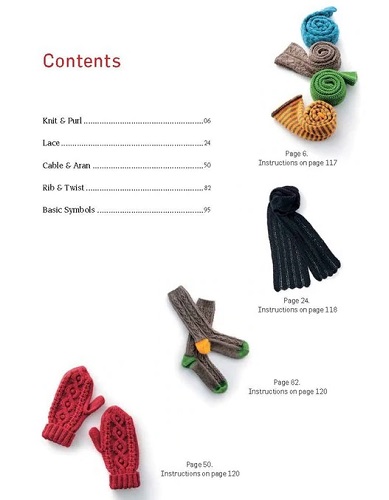
Mini Knit and Purl Scarf: 4 Variations
There are 4 different ways you could knit this easy scarf (and, in fact, you could keep making additional variations of it using the other knit and purl combination stitches included in this book). I think any knitter, even a novice knitter, could most likely succeed with knitting these scarves.
Lacy Scarf Knitting Pattern
This beautiful scarf utilizes a simple but lovely lace knitting chart plus a helpful schematic. The scarf is knitted in 2 pieces and then grafted together using the kitchener stitch. I believe most knitters, even novice knitters, could probably succeed with making this pattern.
Two-Tone Rib and Twist Socks Knitting Pattern
These cabled socks are knitted using a schematic plus a charted design that looks like maybe it could also be used to knit mittens (I am not 100% sure about that, but I mention it because the chart indicates a thumb hole.) In any case, other than that detail, the instructions do not make any mention of how to knit mittens using the chart; and, in fact, they don’t go into much detail about how to make the socks, either. This is clearly a pattern for experienced knitters who have already enjoyed some success with sock knitting; I think this design is probably too challenging for the average beginner to succeed with.
Cabled Mittens Knitting Pattern
These mittens are absolutely gorgeous! The pattern includes a chart plus schematic and several diagrams. Written text helps you understand the materials and finishing details.
The Types of Knitting Stitches Included in This Book
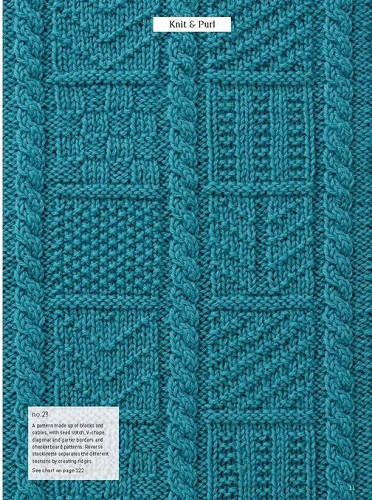
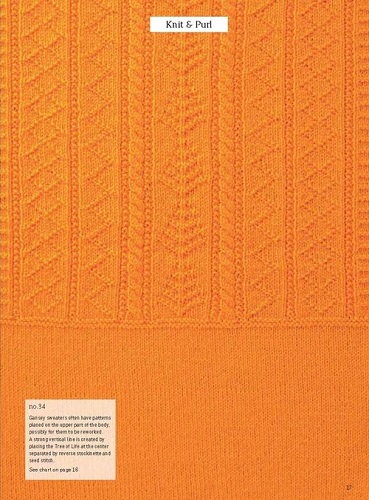
This book includes the following types of knitting stitch patterns:
- Knit and purl stitch combinations
- Lace stitches
- Cable and aran stitches
- Rib and twist stitch combinations
Most of the knitting stitches in this book use only one yarn color; however, there are some exceptions. There are a few colorwork patterns included in the knit and purl section of the book. But if you’re primarily interested in colorwork knitting stitch combinations, this book is likely to be disappointing to you. In that case, I’d recommend checking out Keiko Okamoto’s Japanese Knitting Stitches book (which is my favorite knitting stitch dictionary!) and Andrea Rangel’s Alternknit Stitch Dictionary. Both of those books have a greater emphasis on color knitting stitch patterns than this book does.
The Best Things About This Book
There are so many wonderful things about this book that it’s hard to know where to start in describing them all. For starters, the projects included in the book are simply marvelous. They are classic designs that are appealing and wearable.
The stitch patterns are all useful ones — no duds in the bunch.
I find the rib knitting stitch patterns of particular interest, because I know they will be useful for designing every imaginable type of wearable project, from mittens to sweaters to hats and socks. If you’re tired of using the usual k2p2 ribbing for all your sweaters, I think you’ll really enjoy looking at all the varied options included in this book.
The book includes an excellent exploration of cable knitting, ranging from the ultra-simplest possible cables on up through complex and beautiful cable combinations and panels like the one pictured on the front cover of the book. There are quite a few of these impressive combinations, all charted out in detail for you to use in your own knitting projects. They would make spectacular blankets, pillows, sweaters, tote bags or similar items — and so much of the work is done for you that it really wouldn’t take much effort to design these types of projects using the stitch patterns from this book.
This book has a helpful section in the back featuring explanations for all the symbols found in the book. This section includes a visual representation of each symbol, plus line art diagrams and text instructions explaining how to do each technique.
From my point of view as a professional designer, one of this book’s most compelling selling points is the time it is likely to save you in your own knit design process. Here you have a collection of extremely appealing, wearable, classic stitch patterns to draw from. All you have to do is take them and use them. Working out this many stitch designs from scratch would take you soooooooooo much time — but Yoko has invested the time so you don’t have to. She has given you the gift of an incredible shortcut.
Right now, in the USA, federal minimum wage is $7.25 USD per hour. At Amazon’s current price for the book, it’s valued at less than what 2 hours of time would cost for the lowest paid workers in the country.
Unless you’re an unusually fast designer, it would probably take you more than 2 hours to work out how to do JUST ONE of these knitting stitches. You do the math on how much time it would take you to design 200 knitting stitches of this quality and calibre — and I think you will start to get the idea about why I think this book is an incredible value for its asking price. You get a lot for your money here — 200 highly creative knitting stitches, PLUS the finished knitting projects, all for a price that’s equivalent to less than 2 hours of your time (and perhaps FAR less than 2 hours of your time if you earn substantially more than minimum wage).
Other Observations About This Book
If you own other knitting stitch dictionaries, it is possible that there may be some overlap between the ones you already own and the ones found in this book. This book does include a few ultra-basic stitches such as basic ribs, basic garter stitch designs and super-simple cable stitches that are likely to be found in other knitting references.
The team at Tuttle Publishing cites several of the legendary classic knitting texts in the references section at the back of the book, including Barbara Walker’s first 3 treasuries of knitting patterns. I am a complete idiot, because I sold my Barbara Walker treasuries before my husband and I moved aboard our sailboat to take off sailing halfway around the globe. I have often regretted doing that (selling the books, I mean, not the actual sailing), and I certainly regret it at this moment, because I would find it helpful to be able to compare the contents in this book against the contents in those books to see how much overlap actually exists between them. I’m guessing it is a minimal amount, but I am not sure about that.
But, even if there is some similar material, there are a couple of obvious ways in which this book is substantially different from Barbara Walker’s classic texts. The first is that this book is printed in full color, whereas Barbara Walker’s texts are printed in black and white. Many knitters would prefer to work from a book printed in color, and this one has that advantage.
Another difference is the charting convention. My understanding of the situation is that this book uses standard Japanese charting convention, which is different from Barbara Walker’s charting convention.
Another obvious and important difference: As I mentioned earlier, Yoko Hatta has curated this collection of stitches, including only the ones that are her favorites — the most useful and usable stitches that she relies on in her own design work.
If you compare this volume against Barbara Walker’s massive collection of hefty stitch dictionaries, it’s clear that Barbara Walker’s collections are much more comprehensive. However, if you’re a new knit designer, it may be a good thing that this book offers you fewer initial choices — because more choices can lead to choice paralysis and overwhelm. That might or might not be an issue for you — but if it is, this book is likely to be an excellent choice of knitting stitch dictionaries for you. Yoko’s book offers you a whole lot of viable choices, all of which have been tried, tested and proven in her own design work — but not so many choices that overwhelm would be a likely outcome.
Things to Be Aware of Before You Buy This Book
Most of the photos in this book are large enough to be helpful and satisfying. However, I thought the project photos of the finished items — the socks, mittens and scarves — were disappointingly small.
Almost all of the instructions in this book are presented as knitting charts — without extensive accompanying text instructions. I believe this was a smart editorial choice. If written instructions had been included in every case, this would have had to be a multi-set encyclopedia rather than the concise knitting stitch dictionary you have here. But, the downside is, if you prefer working from written instructions rather than charts, you’re out of luck with this book. Any knitter who prefers working from text instructions will probably be happier with a different stitch dictionary than this one. But if you prefer working from charts, I think you’ll be pleased with this book.
I’m reviewing the paperback version of this book — and I would totally recommend it. Both the paper quality and the quality of the binding are excellent.
This book’s page layout requires you to either flip back and forth between pages, or make copies of your frequently used pages to avoid having to flip back and forth. For that reason, I wouldn’t recommend buying the Kindle edition as your only working copy of the book. As far as I know, you won’t be able to print pages from the Kindle version, and you’re likely to find it challenging to flip back and forth between pages.
However, what I WOULD recommend: Buying both a Kindle edition AND a paperback copy to use together, if you are so inclined. You’ll most likely be able to work more efficiently if you are able to use both a digital and physical edition together. But if you don’t have a Kindle, no worries; you could achieve similar efficiency by simply photocopying the list of chart symbols and keeping them handy so you don’t have to do so much page flipping when you work from the paperback copy of this book.
Conclusion
I’m delighted to recommend this book to other knitting enthusiasts, particularly to knit designers and aspiring knit designers. If you’re a new knitter, and you don’t already own any knitting stitch dictionaries, this one would be an excellent choice for your first one. I’m positive that experienced knitters will also find significant value in this book. Bottom line, I think knitters of every skill level are likely to enjoy owning this book.
Where to Buy This Book:
Similar Knitting Books
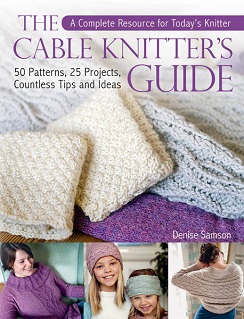
- Keiko Okamoto’s Japanese Knitting Stitches: A Stitch Dictionary With 150 Amazing Patterns — This book offers you a glorious variety of stitch patterns, including stranded color knitting patterns; stitch patterns for smocking on your knitting; knit and purl stitch patterns; cable and twist patterns; three-dimensional stitch patterns; lace and openwork stitch patterns and more.
- Japanese Knitting Stitch Bible — If you’re interested in knitting the most impressive, the most jaw dropping, the most spectacular knitting projects ever, than this book absolutely NEEDS to be on your bookshelf. It is hands down the most extraordinary stitch dictionary I have ever seen.
- Japanese Knitting — This book features stylish, wearable, unique and lovely patterns for knitting and crocheting womenswear. If you’re seeking a new knitting or crochet project to get started on, this book would be an excellent place to find numerous worthy options.
- The Cable Knitter’s Guide — If cable knitting is of interest to you, The Cable Knitter’s Guide is an excellent book to consider owning. It is a stitch dictionary that also features a sizable number of knitting projects made using the stitch patterns from the book. For aspiring designers, it is incredibly valuable to see how an experienced designer translates the cable patterns into finished projects. I love this book and find it exceptionally useful.
- Click or tap HERE to find more outstanding Japanese knitting books.
Knitting Tools and Supplies
Learn More About Knitting
- Click here to find our picks for the best knitting books of 2023 and beyond.
- Find the Most Important Knitting Abbreviations You Need to Know
Posted By: Amy Solovay
This page was last updated on 8-4-2023.